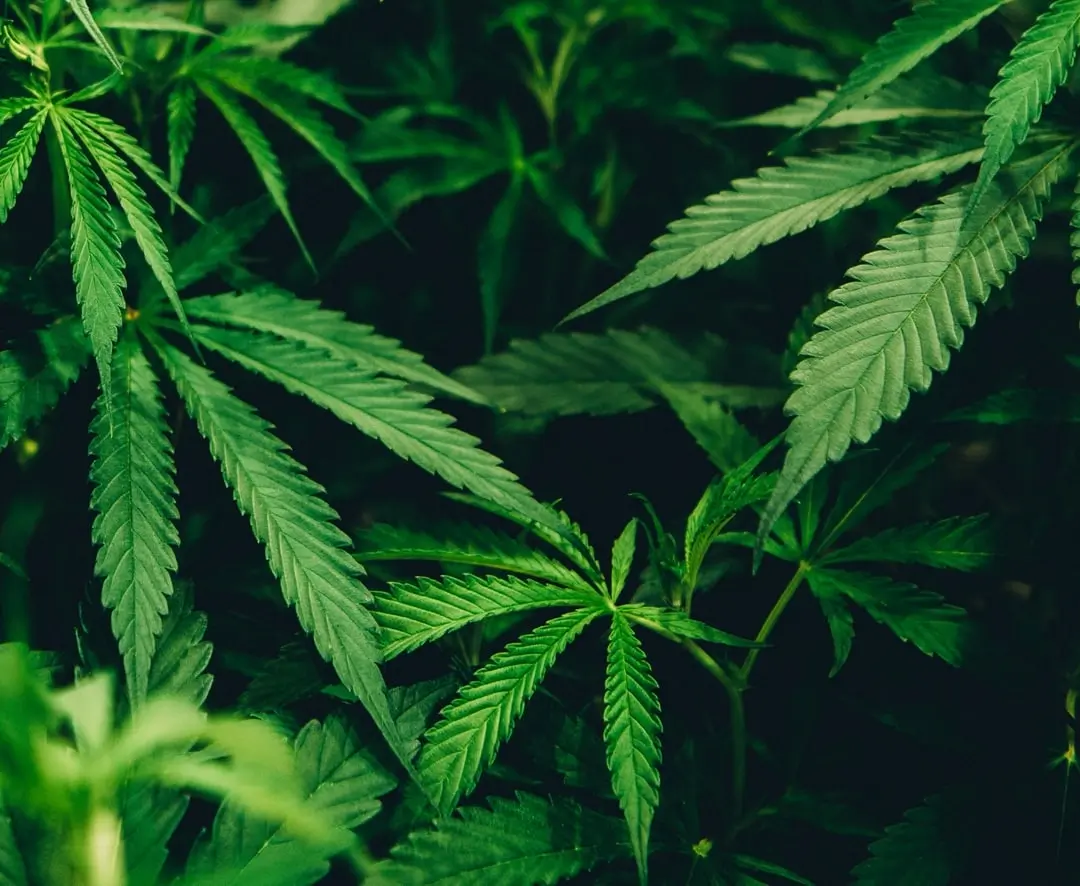Cannabinoids are naturally occurring chemical substances that make up at least 140 of the over 500 known compounds found in the cannabis plant. Not exclusive to cannabis, they can be found in a number of other botanicals as well. When cannabinoids are produced in plants they are referred to as phytocannabinoids, to be distinguished from those produced within the human body, which are known as endogenous cannabinoids or endocannabinoids. Cannabinoids are invaluable to cannabis, as they are responsible for many of the therapeutic and psychoactive properties experienced when using the plant.
Cannabinoids in Cannabis
The more than 500 compounds identified in the cannabis plant all develop in the trichomes, which are found throughout the stalk, stems and leaves, though the highest concentration of trichomes grows on the cannabis flowers. Trichomes are tiny resin glands that look like hairs or minuscule mushrooms, containing compounds such as cannabinoids, terpenes, and flavonoids.
A Brief History of Phytocannabinoids
Knowledge and application of the medicinal properties of the marijuana plant are thought to date back 5,000 years ago to ancient China. However, it was not until the early 20th century that modern science began to delve into its unique properties.
In the late 1800s, Cannabinol (CBN) was the first individual phytocannabinoid to be identified. By the early 1930s, British chemist R.S. Cahn clarified its molecular structure. In the 1940s, Roger Adams, an organic chemist, was the first to discover Cannabidiol (CBD) and Tetrahydrocannabinol (THC).
Adams’ work paved the way for Dr. Raphael Mechoulam, who would come to be known as the father of cannabis research. Dr. Mechoulam uncovered both the CBD and THC molecules’ complete structures and subsequently synthesized them in 1965. He later confirmed the existence of the endocannabinoid system and his work has contributed significantly to the current scientific understanding of cannabis.
How do Cannabinoids Work in the Human Body?
Phytocannabinoids interact with the cannabinoid receptors which are present throughout the body. They bind to the body’s receptors in the same way as endocannabinoids in what is known as the endocannabinoid system (ECS). This interaction induces molecular changes that are responsible for the effects cannabis produces within the human body.
Understanding the Endocannabinoid System
A group of researchers led by famed cannabis researcher Dr. Raphael Mechoulam confirmed this complex cell-signaling system in 1992 at the Hebrew University in Jerusalem. They isolated a lipid molecule that bonded with the previously discovered cannabinoid receptor identified by experts in 1988 at St. Louis University Medical School. This molecule came to be known as anandamide and was the first discovered endocannabinoid.
Broadly speaking, the ECS consists of the endocannabinoids, cannabinoid receptors and enzymes. The primary endocannabinoids consist of anandamide and 2-Arachidonoylglycerol (2-AG). The two key cannabinoid receptors are CB1 and CB2, which are found throughout the body in differing distributions across the central and peripheral nervous systems. The highest concentration of CB1 receptors are found in the brain, whereas the CB2 receptors are most commonly found in the immune system.
Medical research suggests that the ECS is involved in maintaining homeostasis or balance within the body. It is believed to help regulate mood, appetite, pain response, anxiety, immune function, and memory and is sometimes referred to as the body’s universal regulator. Furthermore, because there are no ECS receptors present in the brainstem where critical life functions are managed, it is believed that cannabis cannot lead to fatal outcomes. The National Cancer Institute explains,
“Because cannabinoid receptors, unlike opioid receptors, are not located in the brainstem areas controlling respiration, lethal overdoses from cannabis and cannabinoids do not occur.”
Given the progression of cannabis legalization internationally, research in this area has become more widely accepted and understanding of how cannabis interacts with the human body and its potential medical applications continues to evolve.
THC: The Most-Studied Phytocannabinoid
THC, or tetrahydrocannabinol, is the most studied and most well-known of the cannabinoids present in the marijuana plant, as well as being the most psychoactive component.
There are three distinct THC cannabinoids, which are differentiated in terms of their degree of psychoactivity and how strongly they bind to CB1 and CB2 receptors. Delta-9 THC is the most abundant and the most robust psychoactive agent, followed by the less potent Delta-10 THC and lastly Delta-8 THC.
The compound can produce an extreme euphoria that increases with higher concentrations. It also has the potential to cause anxiety, paranoia, and sometimes hallucinations. In addition, users can experience short-term memory loss, reduced coordination, red eyes, and an increase in appetite from THC.
From a therapeutic perspective, the mood-boosting plant chemical may help with pain relief, opioid replacement, PTSD, insomnia, irritable bowel disease, depression, and side effects of cancer treatment, among other potential applications.
CBD: The Non-Intoxicating Cannabinoid
The second-most well-researched cannabinoid is CBD. Formally known as cannabidiol, CBD is a non-intoxicating compound with a similar chemical structure to THC. Despite its similar structure, it does not interact with the cannabinoid receptors in the same way, and does not affix to the CB1 or CB2 like THC does. Instead, CBD acts as an allosteric modulator, “which means that it can either enhance or inhibit how a receptor transmits a signal by changing the shape of the receptor.” CBD can loosen THC’s grip on the CB1 receptor which in turn reduces THC’s psychoactivity. As such, dosing instructions for cannabis users may involve differing THC:CBD ratios depending on the desired effect and level of experience.
Potential benefits of CBD include lessening inflammation, relieving anxiety, reducing stress and improving symptoms of several conditions, such as seizures, ADHD, autism, insomnia, and digestive disorders.
Lesser Studied Cannabinoids
Outside of THC and CBD, the remaining phytocannabinoids are considered secondary because they represent 1% or less of the total phytocannabinoid content in the marijuana plant. The more common among the lesser-known compounds include:
Cannabigerol (CBG)—CBG is a non-intoxicating cannabinoid like CBD that was discovered in 1964. CBGa, the acidic form, is often referred to as the mother of all cannabinoids because it is the first to form in the trichomes. It shares some of the same potential benefits as the other cannabinoids, including inflammation relief, protection from oxidative stress, and promotion of cancer cell death. It may also stimulate appetite like THC.
Cannabidivarin (CBDV)—CBDV is a molecule found in cannabis similar to CBD and is nonintoxicating. It is thought to have anti-epileptic and anti-convulsive properties. Additional potential therapeutic roles for CBDV may include Rett Syndrome, Duchenne muscular dystrophy, and nausea.
Cannabichromene (CBC)–CBC may help with several conditions. It is nonintoxicating and may help prevent tumor growth. Like other cannabinoids, it has anti-inflammatory properties, and research shows it may help in mitigating pain experienced by osteoarthritis patients. Further studies reveal it positively affects healthy brain function and may provide better relief and acne prevention than CBD.
Cannabinol (CBN)— CBN is a unique cannabinoid that forms when THC breaks down over time and degrades. For example, old cannabis or cannabis extracts left unrefrigerated or in the light will have higher levels of CBN. This natural process reduces psychoactivity and increases the sedative effects. Levels of CBN in cannabis are not controlled by genetic factors, but by environmental ones. As a result, there are no high CBN strains available on the market, so the optimal way to obtain it is by oxidizing THC and CBD.
Ultimately, as the understanding of cannabinoids and other prominent compounds advances, patients and consumers alike will be able to employ a more comprehensive knowledge of the cannabis plant and how it can help in achieving their desired outcomes. While many modern cannabis strains tend to have high THC profiles to meet the demands of the recreational market, increasing attention is being paid to CBD and its potential therapeutic properties. In addition to creating more cultivars with higher cannabidiol content, breeders are increasing CBG, THCV, and CBC levels as more studies become available about the benefits of these secondary cannabinoids. The implications of the research in this field will help further guide the medical community towards tailoring specific and effective cannabis-based therapies to specific patient conditions.
© Kanab Inc. – Kanab Inc. is a Toronto based cannabis retail company that honors the historical significance and uses of the cannabis plant across cultures and civilizations. Kanab has now opened its first cannabis dispensary at the intersection of Don Mills Road and York Mills Road in North York region of Toronto, Ontario (South of 401, West of 404 / Don Valley Parkway, and East of Leslie). For more info, please visit: kanab.ca






